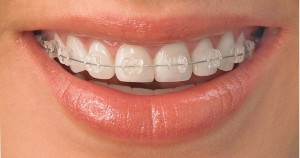What is orthodontic treatment?
Orthodontic treatment straightens your teeth so they look and work better. Braces or other appliances are used to put gentle pressure on your teeth. Over a number of months this pressure can move your teeth into the right position.
People of any age can benefit from orthodontic treatment. Teeth that are crooked, crowded or that stick out affect the way your teeth look and work. Orthodontic treatment not only improves the look of your smile but your health as well. Straight teeth are easier to clean and less likely to get tooth decay or injured. If you are not happy with the way your teeth look or work, orthodontic treatment may help.
A bad bite can make it hard to chew some foods and may cause some teeth to wear down. It can also cause muscle tension and pain. Teeth that stick out are more easily chipped or broken. Crowded and crooked teeth are harder to clean and may be more likely to get cavities and gum disease. Fixing a bad bite improves your smile and your health. Different types of bad bites include an Overbite, a Crossbite, an Overjet and an Open bite.
Who can get orthodontic treatment?
Orthodontic treatment isn’t just for teens, as teeth can be moved at any age. In fact, more and more adults are having orthodontic treatment to improve the look and health of their smile.
From as early as six years of age, some dental defects can be identified and treated by various methods. Early intervention can ensure that subsequent treatments are superfluous or are required to a limited extent.
Your dentist or orthodontist can evaluate if orthodontic treatment is right for you.
In some cases it is helpful to start orthodontic treatment before all the permanent (adult) teeth come in. this is called interceptive orthodontic screening to find out if your child will need orthodontic treatment to correct a bad bite. Interceptive orthodontics allows your dentist or orthodontist to treat or stop a problem as it is developing.
Orthodontic Treatments
Depending on the extent of your bad bite, your dentist or orthodontist may suggest one or a combination of the following orthodontic treatments to correct your bite.
- Braces
- Removable appliances
- Clear aligners
- Oral surgery
- Orthodontic Trainers
Choices in braces
Today’s braces are smaller and less noticeable. Besides the traditional metal braces, there are tooth-colored ceramic braces that are less noticeable.
Lingual technology is a new orthodontic treatment method, in which brackets are secured to the back side of the teeth and, as a result, are completely invisible from the outside.

Self-ligating braces are the modern choice in orthodontics. They have provided a breakthrough in orthodontic treatment and comfort. They don’t use ligatures to hold the archwire – they are self-ligating. So you can forget about the problems associated with elastic bands.
Clear aligners
Each aligner tray is designed to perform a highly controlled, precise movement so that teeth are moved with little or no pain in a gradual and effective manner. All of this is accomplished with the virtually invisible trays at regular intervals — until the teeth are in their final position. They are both comfortable (no metal brackets or wires) and removable.
Removable appliances
Although removable appliances are not as precise as braces, they can move a tooth or a group of teeth. They are fitted by your orthodontist. Removable appliances can be worn before braces are applied, while braces are worn, or on their own to treat specific problems.
Oral surgery in orthodontics
Tooth removal may be needed if you teeth are crowded or if a tooth is badly out of position. Jaw surgery (or orthognathic surgery) may be needed when there are major differences in the size or position of the upper and lower jaws. If your orthodontist thinks you will need jaw surgery, he or she will refer you to an oral and maxillofacial surgeon.
Pre-prosthetic treatment
If a dentist is to guarantee impeccable prosthetic treatment, the position of the affected teeth or adjoining teeth must be taken into consideration. In many cases, pre-prosthetic orthodontic treatment will allow bridge or implant work to be undertaken in places which would not have been possible without this preliminary treatment.
